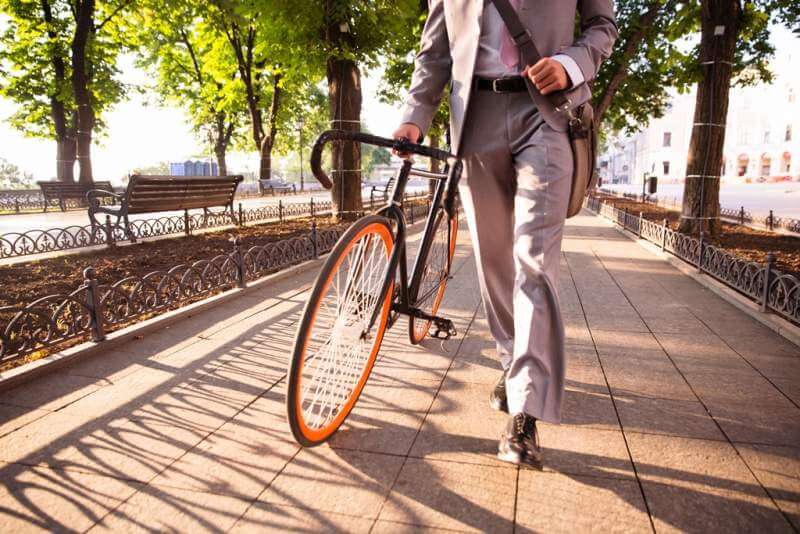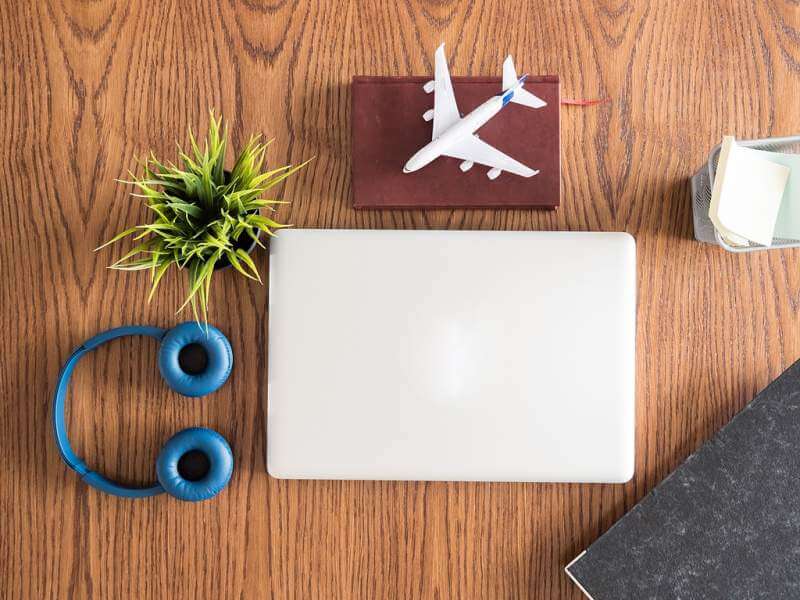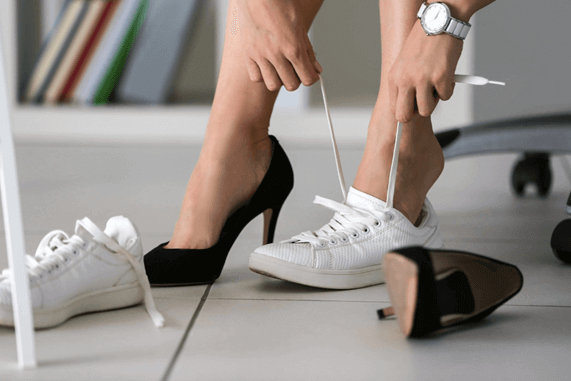American commutes are already long, and they’re getting longer. Many workers find their commutes one of the most frustrating — if not the most frustrating — parts of their day. And commutes don’t just suck up time or make you stressed. They also contribute to a whole list of health problems, including higher blood sugar and cholesterol, increased anxiety and back pain.
But just because you have to commute, that doesn’t mean you also have to let it negatively affect your health. We’ve outline 10 strategies, both large and small, that you can use to make your commute healthier, from wearing compression socks to doing deep breathing exercises.
1. Walk to the office.
 If you only live a short distance from your workplace, try walking there instead of driving. This will get your blood pumping and help combat many of the ill effects of sitting at your desk all day. If you must drive to work, at least take a lap around the building once you park at the office. Otherwise, you’ll go straight from sitting in your car to sitting at your desk, and that much sitting without a break can contribute to bad circulation and swelling.
If you only live a short distance from your workplace, try walking there instead of driving. This will get your blood pumping and help combat many of the ill effects of sitting at your desk all day. If you must drive to work, at least take a lap around the building once you park at the office. Otherwise, you’ll go straight from sitting in your car to sitting at your desk, and that much sitting without a break can contribute to bad circulation and swelling.
2. Ride a bike.
 Just because the office is too far away to walk doesn’t mean it’s too far away to bike. In fact, biking can sometimes be faster than driving a car, especially during rush hour or in dense urban areas. That said, if you haven’t been on a bike in years, trying to navigate the morning rush hour is not the best way to reacquaint yourself with cycling, so know your skill level and plan your commute accordingly.
Just because the office is too far away to walk doesn’t mean it’s too far away to bike. In fact, biking can sometimes be faster than driving a car, especially during rush hour or in dense urban areas. That said, if you haven’t been on a bike in years, trying to navigate the morning rush hour is not the best way to reacquaint yourself with cycling, so know your skill level and plan your commute accordingly.
3. Take a bus or train.
 Sure, you’ll still be sitting on public transportation — at least, if you’re lucky enough to get a seat. But taking the bus or train still encourages walking. You’ll have to walk from your house to the closest station, and again from the stop to your office. If you want to add even more steps into your day, you can get off a stop early and walk the rest of the way for some extra movement.
Sure, you’ll still be sitting on public transportation — at least, if you’re lucky enough to get a seat. But taking the bus or train still encourages walking. You’ll have to walk from your house to the closest station, and again from the stop to your office. If you want to add even more steps into your day, you can get off a stop early and walk the rest of the way for some extra movement.
4. Shorten your commute.
 The less time it takes you to commute, the less stressed you’ll be and the smaller its effects on your health will be. If it’s feasible, you can consider moving closer to the office. If it’s not, many offices are now allowing employees to work from home at least part of the time to reduce their commute time.
The less time it takes you to commute, the less stressed you’ll be and the smaller its effects on your health will be. If it’s feasible, you can consider moving closer to the office. If it’s not, many offices are now allowing employees to work from home at least part of the time to reduce their commute time.
5. Find alternate routes.
 Sure, the interstate is often the most direct route, at least on paper — but a freeway filled with bumper-to-bumper cars will only cause your stress levels to spike, and it might not save you that much time anyways. See if you can find an alternative route where you’ll deal with less traffic and fewer accidents, even if it does add a little distance to your commute.
Sure, the interstate is often the most direct route, at least on paper — but a freeway filled with bumper-to-bumper cars will only cause your stress levels to spike, and it might not save you that much time anyways. See if you can find an alternative route where you’ll deal with less traffic and fewer accidents, even if it does add a little distance to your commute.
6. Sit up straight.
 Poor posture can impede your circulation, and this is equally true whether you’re sitting at a desk or in a car. If you drive, your seat back should be positioned just a little over 90 degrees, and you should be far enough away from the dashboard that your knees don’t touch it as you work the pedals. If you’re sitting on public transportation, try not to cross your legs, as this can also compromise circulation. If you have back issues, a lumbar support pillow can help you get into a more healthful and comfortable position.
Poor posture can impede your circulation, and this is equally true whether you’re sitting at a desk or in a car. If you drive, your seat back should be positioned just a little over 90 degrees, and you should be far enough away from the dashboard that your knees don’t touch it as you work the pedals. If you’re sitting on public transportation, try not to cross your legs, as this can also compromise circulation. If you have back issues, a lumbar support pillow can help you get into a more healthful and comfortable position.
7. Wear compression hosiery.
 Movement is one of the best ways to encourage proper circulation, but if you’re trapped in a car, bus or train, you won’t always be able to get up and move around to get your blood flowing. That’s where compression garments come in. Compression gear is made from specially woven fabric that applies graduated pressure up your limbs, encouraging the blood to keep flowing back towards your core rather than pooling in your lower legs. Many compression socks are designed to look just like regular socks, and compression pantyhose are also available for women who must follow a stricter office dress code.
Movement is one of the best ways to encourage proper circulation, but if you’re trapped in a car, bus or train, you won’t always be able to get up and move around to get your blood flowing. That’s where compression garments come in. Compression gear is made from specially woven fabric that applies graduated pressure up your limbs, encouraging the blood to keep flowing back towards your core rather than pooling in your lower legs. Many compression socks are designed to look just like regular socks, and compression pantyhose are also available for women who must follow a stricter office dress code.
8. Put on your comfiest shoes.
 Even if you sit for your entire commute, you don’t have to wear the same shoes you’ll wear in the office. Rather than put on high heels or uncomfortable loafers, choose supportive orthopedic shoes that will cushion your feet during your commute. Wearing the proper shoes is even more important if you run or bike to work. You only have one pair of feet, so take care of them!
Even if you sit for your entire commute, you don’t have to wear the same shoes you’ll wear in the office. Rather than put on high heels or uncomfortable loafers, choose supportive orthopedic shoes that will cushion your feet during your commute. Wearing the proper shoes is even more important if you run or bike to work. You only have one pair of feet, so take care of them!
9. Occupy your mind.
 Obviously, you should never engage in distracted driving, biking or walking as you commute to work. But if traffic is moving relatively slowly and you know the route, some absorbing audio entertainment can help the frustrating miles go by faster. Call a friend and talk on the phone, play an interesting podcast, sing along to a favorite album or read a book if you’re on public transportation.
Obviously, you should never engage in distracted driving, biking or walking as you commute to work. But if traffic is moving relatively slowly and you know the route, some absorbing audio entertainment can help the frustrating miles go by faster. Call a friend and talk on the phone, play an interesting podcast, sing along to a favorite album or read a book if you’re on public transportation.
10. Take deep breaths.
 Commuting can be stressful, but a bus or train isn’t exactly an ideal environment to meditate in. And definitely don’t try meditating if you’re behind the wheel of a car — eyes and attention on this road, please! But even with these caveats, you can still engage in deep breathing exercises if you find your stress levels spiking at a traffic snarl. Inhale through your mouth and exhale through your nose over several counts, trying to breathe deeply from the diaphragm instead of from the chest.
Commuting can be stressful, but a bus or train isn’t exactly an ideal environment to meditate in. And definitely don’t try meditating if you’re behind the wheel of a car — eyes and attention on this road, please! But even with these caveats, you can still engage in deep breathing exercises if you find your stress levels spiking at a traffic snarl. Inhale through your mouth and exhale through your nose over several counts, trying to breathe deeply from the diaphragm instead of from the chest.
You may not be able to stop commuting altogether, but there are steps you can take to improve your commute and regain more control over it. If your commute has been taking a toll on your health recently, try one or more of these strategies to make it less stressful.
Author Bio:
Kaki Zell is a holistic health student studying at MUIH. When she’s not writing or studying, you can find her downtown practicing yoga or scoping out the newest plant based restaurants.
